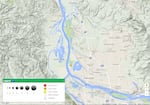
This Pacific Northwest Seismic Network map shows the epicenter of the 2.8-magnitude earthquake that stuck Clark County on Thursday, Nov. 12, 2015.
In little more than a week, a series of earthquakes has hit around the Ring of Fire — first in Myanmar, then Japan, and then Ecuador, where hundreds of people died.
The Ring of Fire is the horseshoe-shaped zone around rim of the Pacific Ocean. It’s very seismically active, and it includes the Pacific Northwest, where there’s growing awareness that a megaquake could strike at any time.
All this got us wondering if movement in one part of this zone influences earthquake activity in the other parts. All Things Considered host Kate Davidson talked with Chris Goldfinger, a geology and geophysics professor at Oregon State University.
Q&A with Oregon State University professor Chris Goldfinger
Kate Davidson: So, you can probably answer this pretty quickly. Does seismic activity in Japan or Ecuador increase the likelihood of an earthquake in the Pacific Northwest?
Chris Goldfinger: Well, not very likely. It's not impossible; we can never rule things out completely, but globally those earthquakes would be considered small relative to the size of a megaearthquake that subduction zones can produce. And so earthquakes of that size acting over such big distances are pretty unlikely to influence Cascadia.
KD: And when you talk about subduction zones, we’re talking about the Cascadia subduction zone here in the Pacific Northwest. Maybe remind our listeners quickly what that is and what we expect in the future.
CG: Subduction zone is a type of major plate boundary where one plate — usually an oceanic plate – is sort of diving underneath another one, usually a continental plate like the U.S. The biggest earthquakes of all come from the boundary between the two plates, and there's a lot of surface area there, and they can generate magnitude 9 — even larger — earthquakes.
KD: So, can you explain why it is — your answer to the first question — that these earthquakes in Japan or Ecuador would not necessarily affect the Pacific Northwest? Is is just because of the size? I mean, a listener might think that, if we’re talking about tectonic plates, imagine it as a rug: if you yank one part of the rug, you might expect the whole thing to move. Why does it not move in this case?
CG: The thing is though that the crust of the Earth is really extremely thin relative to the volume of the Earth. So, you can think of the crust as almost like a sheet of paper. It's almost paper thin relative to everything else. So, with such a thin crust, you can push on it or pull on it or have earthquakes at one end of the sheet of paper as it were thousands of miles away, and it really just has no effect on the other ones because all the energy is absorbed locally. So, that's sort of the bottom line. Imagine if you, say, took a 30-foot-long 2-by-4 and nailed a nail into one end of it and split it, you wouldn't expect it to split at the other end because the forces that you transmit over that distance would be really small.
KD: If those forces are small, can you give us a basic idea of what is behind the study of remote triggering of earthquakes?
CG: That's a great question. And that's why I gave a caveat to this because you can remotely trigger earthquakes in a couple of ways. You can trigger them just by the passage of seismic waves, and that's been demonstrated to occur. We had some earthquakes along the San Andreas triggered by the waves from the Tōhoku 2011 earthquake in Japan. But these are very, very small earthquakes, and so the caveat is that we don't really understand exactly how big of an earthquake you might be able to trigger with such very distant waves like that. It could be that you — once in a great while — you could launch a cascade, where you triggered a small earthquake at a big distance, and it, in turn, triggered a bigger one and a bigger one and had sort of a cascading effect to a very large one. We actually really — nobody, I think, really knows whether that's possible or not. It's just has never occurred in anything we have observed.
